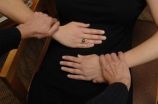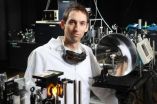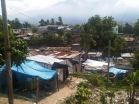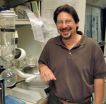(Press-News.org) A new University of Colorado Boulder study indicates an ancient form of complementary medicine may be effective in helping to treat people with mild traumatic brain injury, a finding that may have implications for some U.S. war veterans returning home.
The study involved a treatment known as acupressure in which one's fingertips are used to stimulate particular points on a person's body -- points similar to those stimulated with needles in standard acupuncture treatments, said CU-Boulder Professor Theresa Hernandez, lead study author. The results indicate a link between the acupressure treatments and enhanced cognitive function in study subjects with mild traumatic brain injury, or TBI.
"We found that the study subjects with mild traumatic brain injury who were treated with acupressure showed improved cognitive function, scoring significantly better on tests of working memory when compared to the TBI subjects in the placebo control group," said Hernandez, a professor in CU-Boulder's psychology and neuroscience department. "This suggests to us that acupressure could be an effective adjunct therapy for those suffering from TBI."
The acupressure treatment type used in the study is called Jin Shin. For the study, Hernandez and her colleagues targeted the 26 points on the human body used in standard Jin Shin treatments ranging from the head to the feet. The study subjects all received treatments by trained Jin Shin practitioners.
According to practitioners, Jin Shin acupressure points are found along "meridians" running through the body that are associated with specific energy pathways. It is believed that each point is tied to the health of specific body organs, as well as the entire body and brain, Hernandez said.
"Think of the meridians as freeways and the pressure points as towns along the way," she said. "When there is a traffic jam in Denver that causes adverse effects as far away as Boulder, clearing the energy blocks, or in this case traffic jams, helps improve flow and overall health."
The study involved 38 study subjects, each of whom was randomly assigned to one of two groups -- an experimental group that received active acupressure treatments from trained experts and a control group that received treatments from the same experts on places on the body that are not considered to be acupressure points, acting as a placebo. The study was "blinded," meaning the researchers collecting data and the study participants themselves did not know who was in the experimental group or the placebo group until the end of the study.
The team used a standard battery of neuropsychological tests to assess the results. In one test known as the Digit Span Test, subjects were asked to repeat strings of numbers after hearing them, in both forward and backward order, to see how many digits they could recall. Those subjects receiving active acupressure treatments showed increased memory function, said Hernandez.
A second standard psychology test used for the study, called the Stroop Task, measured working memory and attention. The test subjects were shown the names of colors like blue, green or red on a computer screen. When the names of the particular colors are viewed on the screen in a different color of ink -- like the word "green" spelled out in blue ink -- test subjects take longer to name the ink color and the results are more error-prone, according to Hernandez.
The Stroop Test subjects in the CU-Boulder study wore special caps wired with electrodes to measure the brain activity tied to specific stimuli. The results showed those who received the active acupressure treatments responded to stimuli more rapidly than those who received the placebo treatments, Hernandez said.
"We were looking at synchronized neural activity in response to a stimulus, and our data suggest the brains of those in the active acupressure group responded differently when compared to those in the placebo acupressure group," she said.
A paper on the subject was published in the January issue of the Journal of Neurotrauma, a peer-reviewed publication on the latest advances in both clinical and laboratory investigations of traumatic brain and spinal cord injury. Co-authors on the study included CU-Boulder's Kristina McFadden, Kyle Healy, Miranda Dettman, Jesse Kaye and Associate Professor Tiffany Ito of psychology and neuroscience.
Funded by the Colorado Traumatic Brain Injury Trust Fund, the study is believed to be one of the first placebo-controlled studies ever published in a peer-reviewed medical journal showing the benefit of acupressure to treat patients with TBI, Hernandez said.
"We would like to see if the Jin Shin treatment is useful to military veterans returning home with traumatic brain injury, a signature wound prevalent in the wars in Iraq and Afghanistan," said Hernandez. The Jin Shin acupressure treatment can be taught to family and friends of those with TBI and can even be used as a self-treatment, which could allow for more independence, she said.
In a 2010 stroke study led by Hernandez, the researchers concluded that Jin Shin acupressure triggered a larger and faster relaxation response during active treatments and a decreased stress response following active treatments compared with what was seen in placebo treatments. Hernandez and her colleagues are embarking on a new study on the use of Jin Shin acupressure in athletes to see if the enhanced relaxation response and decreased stress seen in the stroke study can reduce the likelihood of athletic injury.
In 2002, Hernandez partnered with former Colorado Rep. Todd Saliman to initiate the Colorado Traumatic Brain Injury Trust Fund, a statute that has generated nearly $2 million to the state annually since 2004 from surcharges to traffic offenses like driving while impaired and speeding. Roughly 65 percent of the money goes toward rehabilitation and care services for individuals with TBI, about 30 percent goes for TBI research and 5 percent for TBI education. Because of the statute, nearly 4,000 Colorado citizens with TBI have received care and rehabilitation services for brain injuries.
Hernandez will be honored on March 3 in Denver by the Colorado Traumatic Brain Injury Program with the establishment of the annual Theresa D. Hernandez TBI Trust Fund Community Award, becoming its first recipient. Saliman also will be honored at the ceremony.
INFORMATION:
U. of Colorado study shows acupressure effective in helping to treat traumatic brain injury
Treatment has implications for US veterans returning home from war
2011-03-01
ELSE PRESS RELEASES FROM THIS DATE:
Study finds breast cancer incidence rates no longer declining in US women
2011-03-01
ATLANTA –February 28, 2011– A sharp decline in breast cancer incidence rates among non-Hispanic white women in the U.S. after a dramatic drop in the use of postmenopausal hormone therapy did not continue through 2007, according to a new study from the American Cancer Society and the National Cancer Institute. While there are several possible explanations for the recent stabilization, it may indicate that the decrease in breast cancers thought to be related to postmenopausal hormone use has bottomed out. The study appears online in Cancer Epidemiology Biomarkers and Prevention ...
Student innovation at Rensselaer holds key to safer remote detection of dangerous materials
2011-03-01
Troy, N.Y. – Benjamin Clough has developed a novel method for eavesdropping on terahertz information hidden in invisible plasma acoustic bursts. The doctoral student at Rensselaer Polytechnic Institute has demonstrated a promising technique that employs sound waves to boost the distance from which researchers can use powerful terahertz technology to remotely detect hidden explosives, chemicals, and other dangerous materials.
Clough, a student in the Department of Electrical, Computer, and Systems Engineering at Rensselaer, is one of three finalists for the 2011 $30,000 ...
NYU physicists develop potent packing process
2011-03-01
New York University physicists have developed a method for packing microscopic spheres that could lead to improvements in commercial products ranging from pharmaceutical lotions to ice cream. Their work, which relies on an innovative application of statistical mechanics, appears in the Proceedings of the National Academy of Sciences.
The study aimed to manipulate the properties of emulsions, which are a mixture of two or more immiscible liquids. The NYU researchers examined droplets of oil in water, which form the basis of a range of consumer products, including butter, ...
NYU researchers identify neural circuits used in processing basic linguistic phrases
2011-03-01
New York University researchers have isolated neural activity that reflects basic mechanisms used by the brain to combine elementary pieces of language in order to construct complex ideas.
The study, which appears in the Journal of Neuroscience, was conducted by Douglas Bemis, a graduate student in NYU's Department of Psychology, and Liina Pylkkänen, an associate professor in NYU's Department of Psychology and Department of Linguistics.
Researchers have long studied the neural regions that underlie the processing of complete sentences and other complex linguistic ...
Share of black S&E degrees from HBCUs declines in 2008
2011-03-01
More than 45 years after the Civil Rights Act of 1964, National Science Foundation (NSF) statistics show minority academic institutions still enroll a substantial number of minority students, but the percentage of minorities earning bachelor's degrees in science and engineering (S&E) from minority-serving institutions has declined over time.
Statistics published today in a report titled "Women, Minorities, and Persons with Disabilities in Science and Engineering: 2011" show that 26 percent of blacks earned S&E bachelor's degrees from historically black colleges and universities ...
Lead contamination in Philadelphia's Chinatown discovered by Jefferson Emergency Medicine team
2011-03-01
PHILADELPHIA – Recently, a research team from the Department of Emergency Medicine at Jefferson Medical College of Thomas Jefferson University discovered an alarming amount of lead contamination in ceramic cooking and eating utensils sold in Philadelphia's Chinatown. The team, led be Gerald O'Malley, D.O., director of Clinical Research; and Thomas Gilmore, M.D., resident, purchased and tested a sampling of Chinese ceramics. Using a LeadCheck®, one area on each item was rubbed with a lead-detecting solution. In almost 30 percent of the items, the area turned pink or red, ...
Team delivers development aid via cell phone animations
2011-03-01
CHAMPAIGN, lll. — A farmer in Niger learns how to protect his crops from insects. A resident of Port-au-Prince or a rural Haitian village learns how to avoid exposure to cholera. An entrepreneur in Mali gets step-by-step instructions on extracting the oil from shea seeds to make shea butter she can sell at a local market.
These people are benefiting from a new approach to sustainable development education that reaches a much larger audience than traditional methods – and at a fraction of the cost. The initiative, led by a team of extension educators and faculty at the ...
A grudge match between humanity and death -- who wins?
2011-03-01
FAIRFAX, Va., February 28, 2011—Death can be terrifying. Recognizing that death is inescapable and unpredictable makes us incredibly vulnerable, and can invoke feelings of anxiety, hatred and fear. But new research by George Mason University psychology professor Todd Kashdan shows that being a mindful person not only makes you generally more tolerant and less defensive, but it can also actually neutralize fears of dying and death.
"Mindfulness is being open, receptive, and attentive to whatever is unfolding in the present moment," says Kashdan. In his latest research, ...
New marker found for Sanfilippo disease
2011-03-01
Sanfilippo disease is a rare disorder caused by the failure of enzymes to break down specific kinds of complex carbohydrates, resulting in their accumulation in cells and often severe physical and neurological problems – and sometimes early death.
In a paper published in the March 4 issue of the Journal of Biological Chemistry, researchers at the University of California, San Diego School of Medicine, led by Jeffrey D. Esko, PhD, professor in the Department of Cellular and Molecular Medicine, describe the build-up of a novel secondary metabolite in Sanfilippo disease, ...
WSU researcher creates patented personalized therapy that causes cancer cells to kill themselves
2011-03-01
A Wayne State University School of Medicine physician-researcher has developed a personalized therapy to treat a wide range of cancers. The treatment is based on a naturally occurring human enzyme that has been genetically modified to fool cancer cells into killing themselves.
The unique concept, patented by Wayne State University, was successfully demonstrated on melanoma cells that are resistant to routine treatments such as chemotherapy or radiotherapy. Melanoma is a perfect model for testing this new therapy because it is considered the most aggressive form of human ...
LAST 30 PRESS RELEASES:
From fungi to brain cells: one scientist's winding path reveals how epigenomics shapes neural destiny
Schizophrenia and osteoporosis share 195 genetic loci, highlighting unexpected biological bridges between brain and bone
Schizophrenia-linked genetic variant renders key brain receptor completely unresponsive to both natural and therapeutic compounds
Innovative review reveals overlooked complexity in cellular energy sensor's dual roles in Alzheimer's disease
Autism research reframed: Why heterogeneity is the data, not the noise
Brazil's genetic treasure trove: supercentenarians reveal secrets of extreme human longevity
The (metabolic) cost of life
CFRI special issue call for papers: New Frontiers in Sustainable Finance
HKU Engineering scholar demonstrates the smallest all-printed infrared photodetectors to date
Precision empowerment for brain "eavesdropping": CAS team develops triple-electrode integrated functional electrode for simultaneous monitoring of neural signals and chemical transmitters during sleep
Single-capillary endothelial dysfunction resolved by optoacoustic mesoscopy
HKU three research projects named among ‘Top 10 Innovation & Technology News in Hong Kong 2025’ showcasing excellence in research and technology transfer
NLRSeek: A reannotation-based pipeline for mining missing NLR genes in sequenced genomes
A strand and whole genome duplication–aware collinear gene identification tool
Light storage in light cages: A revolutionary approach to on-chip quantum memories
Point spread function decoupling in computational fluorescence microscopy
BacPhase: Long-insert paired-end sequencing for bin marker construction and genome phasing
GmWOX1 regulates the mediolateral polarity of compound leaves in soybean
ChargeFabrica: An open-source simulation tool that aims to accelerate search for high performance perovskite solar cells
High levels of ADAR overexpression induce abundant and stochastic off-target RNA editing in rice protoplasts
On-demand upgraded recycling of polyethylene and construction of sustainable multifunctional materials based on the "LEGO" strategy
New "Stomata in-sight" system allows scientists to watch plants breathe in real-time
Anorexia nervosa may result in long-term skeletal muscle impairment
Narrative-based performance reviews deemed fairest by employees
New insights reveal how advanced oxidation can tackle emerging water pollutants
New review shows how biomass can deliver low-carbon gaseous fuels at scale
Climate change is quietly rewriting the world’s nitrogen cycle, with high stakes for food and the environment
Study finds SGLT-2 inhibitors linked to lower risk of diabetic foot nerve damage
Microbes may hold the key to brain evolution
Study examines how the last two respiratory pandemics rapidly spread through cities
[Press-News.org] U. of Colorado study shows acupressure effective in helping to treat traumatic brain injuryTreatment has implications for US veterans returning home from war



